Enjoy a healthier, low FODMAP, gluten-free version of a British classic comfort food dish with this Low FODMAP Air Fryer Fish and Chips recipe! Using nutritious quinoa flour instead of traditional all-purpose flour for fish breading makes this version of fish and chips low FODMAP, gluten-free, and nutrient-rich. Serve with homemade low FODMAP tartar sauce and low FODMAP ketchup for an even more delicious meal.
Jump to:
How Fish and Chips Work in the Air Fryer
This air fryer fish and chips recipe has been - hands down - one of the most difficult recipes for me to develop. Fish is a delicate ingredient that requires gentle handling and special care. It's wet, and certain flours don't work well when applied to wet ingredients for breading. Plus, if you have an air fryer like mine that doesn't have a lot of room, you have to adjust the ingredients to fit.
Accordingly, because fish is fairly finicky, if you're new to air fryer cooking, I suggest trying out my Low FODMAP Air Fryer Buffalo Chicken Salad recipe or Low FODMAP Air Fryer Shrimp Taco Bowl recipes before this low FODMAP air fryer fish and chips recipe as they are far easier to execute. Chicken and shrimp hold together better, and the breading sticks to them better. If you're looking for a side dish, my Low FODMAP Air Fryer French Fries and Low FODMAP Air Fryer Red Potatoes recipes are also great for beginner air fryer users.
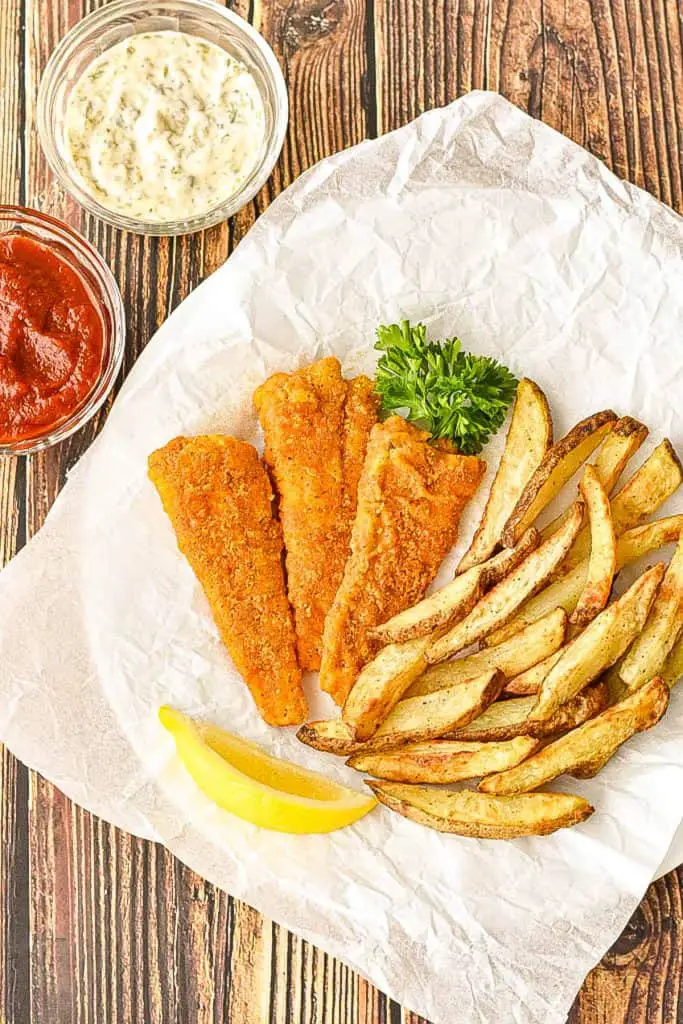
Gluten-Free Flours as Air Fryer Breading
I started this recipe using blanched almond flour on cod. While almond flour works well as a breading for my Low FODMAP Air Fryer Chicken Salad and Low FODMAP Air Fryer Shrimp Taco Bowl recipes, it turned out mushy on cod. I switched to tapioca flour and cassava flour with similar results. Cassava flour, while it works well as a breading for chicken (as in my Low FODMAP Air Fryer + Instant Pot Sweet and Sour Chicken), did not work well as a breading for fish. Plus, according to FODMAP Friendly, cassava flour is only low FODMAP in servings of about 15 grams, which is about 1 heaping tablespoon per serving. While that's more than enough flour for sweet and sour chicken, it's not enough to bread two servings of fish.
I've tried gluten-free all-purpose flour with other air fryer recipes. Generally speaking, it doesn't hold together well as a breading in the air fryer. Since fish is so difficult to bread, I didn't even attempt gluten-free all-purpose flour to bread it.
Hello, Quinoa Flour
Since I was diagnosed with hypoglycemia few months ago, I've been eating more quinoa. Since eating low FODMAP, I have tried to stick to Paleo compliant, grain-free flours; however, as I now need more protein in my life, I decided to give quinoa flour a try. Quinoa flour has been tested by Monash University, and according to their Low FODMAP Diet App, is low FODMAP in servings of up to ⅔ cup or 100 grams per serving. In the world of low FODMAP flour options, that is an amazingly large quantity. Additionally, it's high in protein, fiber, iron, and other nutrients, and is considered by some to be one of the healthiest flours you can eat.
On its own, it has a bit of a bitter taste and odd smell when it's raw; however, so far I've found the bitter taste easy to hide just by putting seasoning in the breading. And, quinoa flour works great as a breading, at least on fish.

The Lack of Space Factor
As fish takes up more space than fries or chicken tenders, it's a bit more difficult to fit fish in the air fryer if you have a 6-quart air fryer basket. Thus, I decided to split the fish fillets in half so that you can fit 3 fillets in one batch. I typically don't mind doing multiple batches, but when you have to cook chips in one batch and fish in another, that's a lot of air frying already. If you prefer to have more than 2 servings of fish, you can easily just double the fish ingredients and cook two batches of fish. Keep the first batch warm in the oven with the chips while the second batch cooks.
Necessary Equipment
The equipment I use to make this Low FODMAP Air Fryer Fish and Chips recipe includes:
- Air fryer - I use an Instant Pot Vortex Plus 10-quart Air Fryer, but smaller air fryers will work.
- Sharp knife
- Cutting board
- Large bowl
- Measuring spoons and cups
- Baking sheet
- 3 medium sized bowls
- 2 whisks
- Parchment paper
- Large spatula
- Instant read thermometer
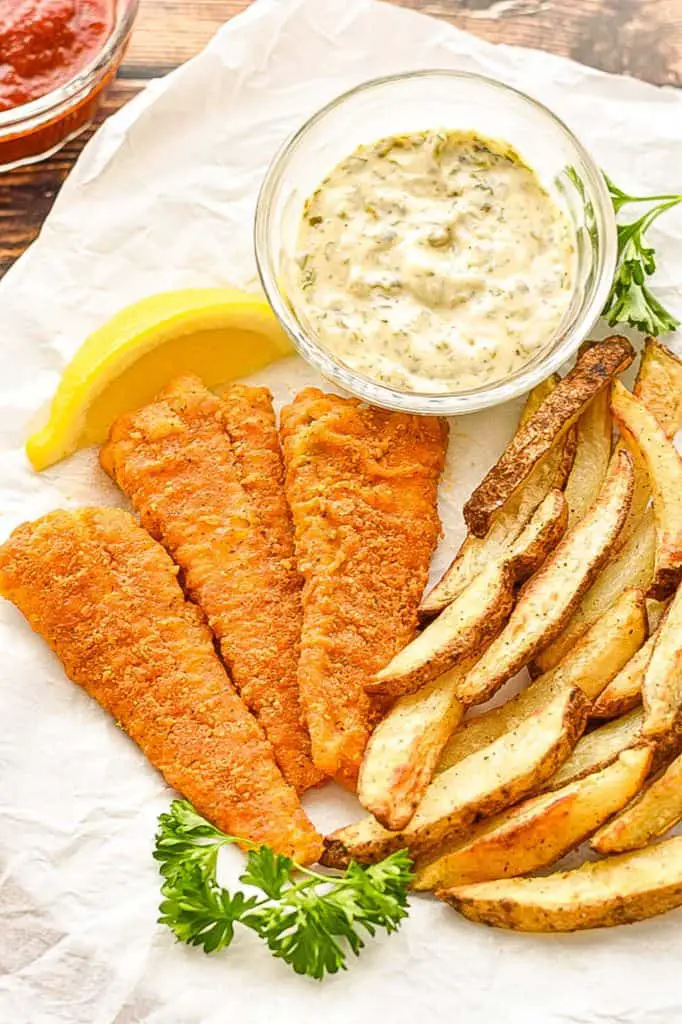
Low FODMAP Air Fryer Fish and Chips: Ingredients & Success Tips
Prepare Condiments (Optional)
To start this recipe, I first prepare the homemade low FODMAP tartar sauce and low FODMAP ketchup. That way, they're ready to go when the fish and chips are done. I get the homemade ketchup going first so that it has time to cool before it's eaten. The tartar sauce requires no cooking and can typically be ready in about 5 minutes. I cover and refrigerate the tartar sauce until I'm ready to serve it.
Prepare the Chips (a.k.a. "Fries")
To begin the fish and chips, I first prepare the chips (also known as "fries" to us North American types). I chop one pound of large russet potatoes lengthwise into ¼-inch strips. This is typically about 2 large potatoes, and the longer the potatoes, the better chips they make. I add the chopped potatoes to a large bowl. Then, I pour 1.5 tablespoons of garlic-infused olive oil on top, tossing them with my hands to coat. This adds garlicy flavor without adding garlic powder, which is high in FODMAPs. Then, I add salt and pepper and toss again with my hands to coat.
Then, I put the air fryer basket inside the inner pot of my Instant Pot Duo Crisp. You can skip this step if you're using a different air fryer. I spray the air fryer basket with avocado oil cooking spray. You can use other types of cooking spray, but I think avocado oil brings the absolute best flavor.
I add the chips to the sprayed air fryer basket and add the air fryer lid to the Instant Pot Duo Crisp. I press the "Air Fry" button, set the temperature to 400°F, set the timer for 7 minutes, and hit the "Start" button. If you're using a different model of air fryer, this procedure will obviously differ - consult your manual for instructions specific to your air fryer. I cook the chips for 21 minutes total or until they're tender and golden brown, tossing the basket every 7 minutes. I ignore the Duo Crisp's "turn food" indication at the halfway point as I find it better to toss the chips twice during the cooking.
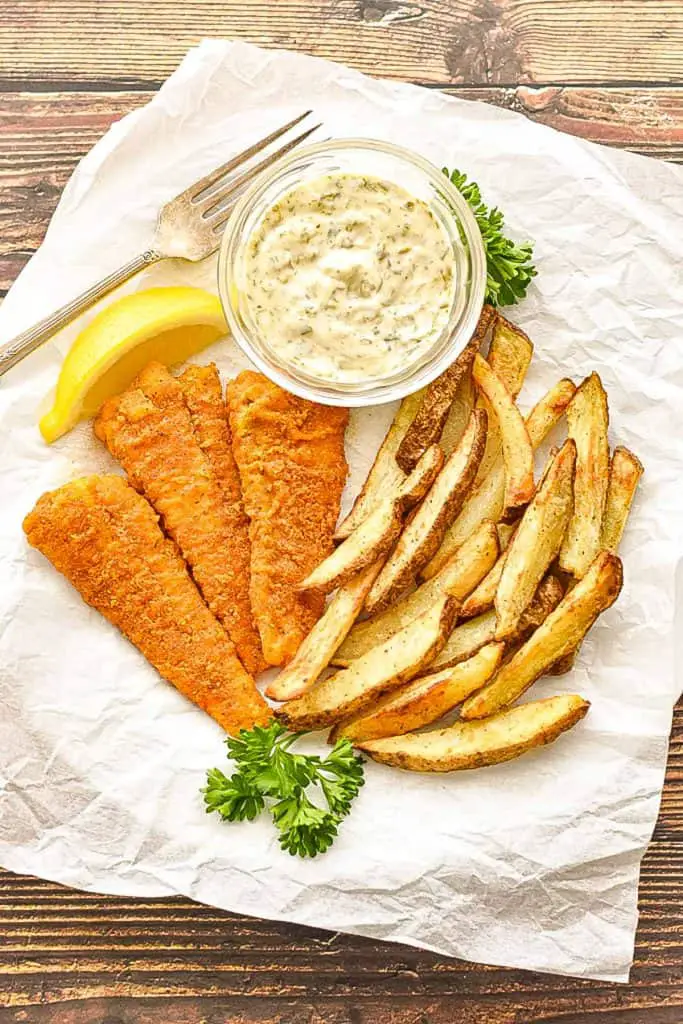
Prepare the Fish
Haddock vs. Cod
Meanwhile, while the chips are cooking, I prepare three haddock fillets to be breaded. Traditionally, both cod and haddock are used in fish and chips recipes. I've chosen haddock for this recipe as it holds together way better than cod and has much better flavor. I typically buy a bag of frozen haddock fillets and thaw them in the refrigerator overnight. Some frozen fish comes in large chunks and portions of fillets instead of long full fillets. I find these large chunks of fish do not work as well for this recipe. They don't fit well in the air fryer basket, nor do they cook evenly along with the thinner fillets.
To prepare the fish, I dry the three fillets the best I can with paper towels. Then, I place them on a cutting board. It's hard to get them perfectly dry as they are fish and wet by nature. The important thing is that they are not sopping wet.
Once dried as much as possible, I place them on a cutting board. Using a sharp knife, I carefully slice the fillets in half lengthwise to make 6 smaller fillets. I affectionately refer to these as “mini-fillets.”
Set Up Dredging Stations
Then, I put three medium bowls and a large piece of parchment on the countertop. These bowls are my "dredging stations" and the parchment is where the fish will rest after they've been breaded.
Dredging Station #1: Tapioca Flour & Seasonings
To the first bowl, I add tapioca flour, salt and pepper and whisk to combine. This is the first place where the fish will be dredged. I find that with these breaded recipes, adding tapioca flour, also known as tapioca starch, makes a better-adhering and more robust breading. Adding seasoning to the tapioca flour ensures that the fish tastes seasoned in its entirety and not just the breading layer. Tapioca flour can be found in some mainstream grocery stores, at health food stores, or can be ordered online.
Dredging Station #2: Egg and Garlic-Infused Olive Oil
To the second bowl, I add a large egg and a tablespoon of garlic-infused olive oil. I whisk them together until the egg is beaten and the oil is more or less combined throughout the egg. This gives the fish some garlicy flavor without using high FODMAP garlic powder.
Dredging Station #3: Quinoa Flour & Seasonings
To the third bowl, I add quinoa flour, paprika, salt and pepper and whisk to combine. This makes a flavorful outer layer for the breading. Quinoa flour can be found in some mainstream grocery stores as well as health food stores or ordered online.
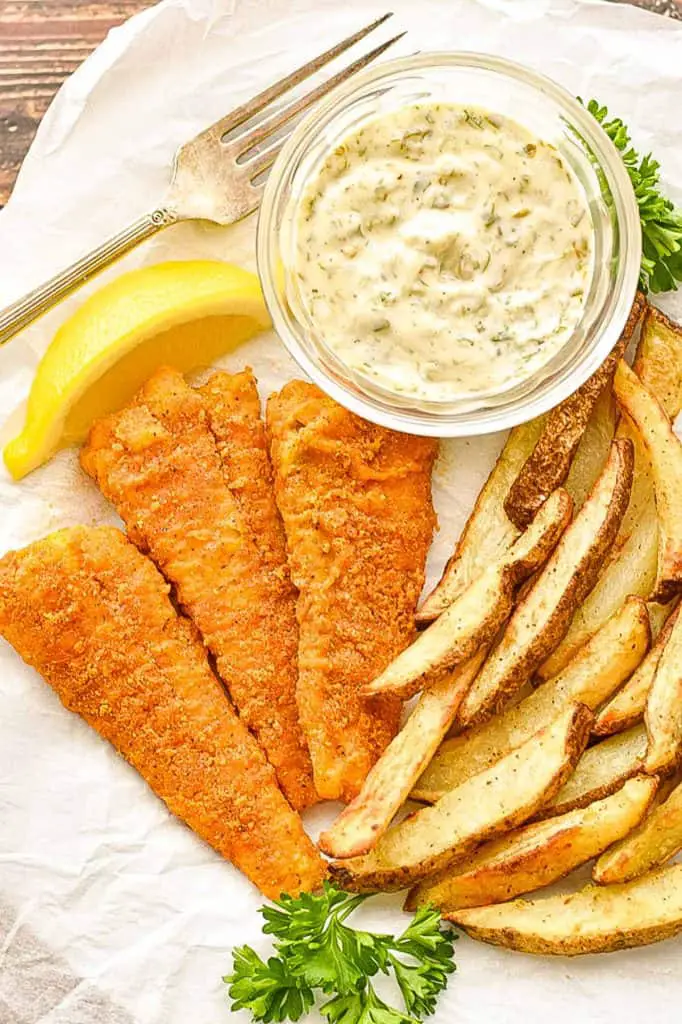
Bread Fish
Using my hands, I dredge my mini-fillets, one at a time, first in dredging station #1 with the tapioca flour, then in dredging station #2 with the egg, and finally in dredging station #3 with quinoa flour, gently shaking off the excess flour and egg after each dredge. I place the breaded mini-fillets on the parchment paper as close to the center of the paper as possible, leaving some extra space on the sides of the fish. Right before I put the fish in the air fryer, I'm going to be spraying the fish with cooking spray. As tends to get messy, the parchment paper is there to catch most of the mess.
I typically have a little leftover quinoa mixture from dredging station #3, so I sprinkle it on top of the breaded fillets to cover up any holes in the breading my fingers may have created while dredging.
Add Fish to the Air Fryer
Okay, so here's where things get tricky. You'll want to follow these instructions to the letter for the best results. I spray the now-empty air fryer basket again with avocado oil cooking spray. As I mentioned above, right before I add them to the air fryer, I spray the top side of the fillets with cooking spray while they’re still on the parchment paper. This can get messy, even with parchment paper involved, but is very necessary so that the fish do not stick.
I then add the fish to the air fryer basket, sprayed side down (this is key), alternating the wide end up so that they all fit in the air fryer basket with some room in-between. Essentially I lay one mini-fillet with the wide end up, and next to it with a little space in-between, I lay another mini-fillet with the narrow end up, so that they fit nicely in the air fryer basket. You don't want them touching as they will not crisp evenly on the sides.
After they’re all in the basket, I spray the tops (the unsprayed side) with more cooking spray. I cook the fish for 6 minutes at 400°F, flipping them with a large spatula halfway through. I find the easiest way to flip them is to come in at them with the spatula on the long side, flipping them over and adjusting them as necessary so that they're not touching other fillets. If they stick at first, gently nudge the fillet to the side a bit with the spatula, and they should let go. I would not recommend using tongs to flip or remove them as they tend to rip the fillets apart and disturb the breading.
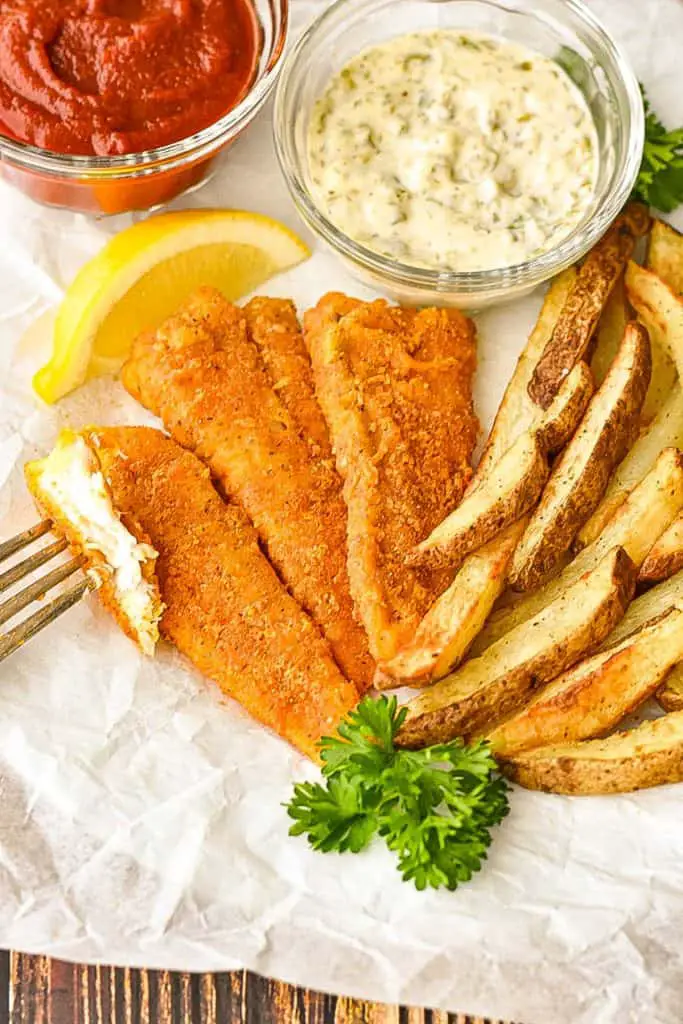
Remove Fish from the Air Fryer
Whew! The hard part is over. Using my large spatula, I remove the cooked fish from air fryer to a serving platter. Using an instant read thermometer, I check the temperature of the thickest mini-fillet. Fish must reach an internal temperature of 145°F to be safely consumed. My fillets easily reach this temp after 6 minutes, but the cooking time may vary depending on your particular air fryer and how thick your haddock fillets are. Then, I retrieve the chips from the oven and add to the serving platter.
Serve Low FODMAP Air Fryer Fish and Chips
Finally, I serve my fish and chips with low FODMAP Tartar Sauce and low FODMAP Ketchup. There are never any leftovers (and probably won't be for you either as it's only a 2 serving recipe). Chips don't keep well in the fridge, so I recommend eating these fish and chips fresh, right out of the air fryer.
Increase the Number of Servings
If you want to increase the number of servings to 4, simply increase the amount of potatoes to 1.5 pounds (the oil and seasoning amounts should still be sufficient) and double all of the ingredients for the fish using the tools in the recipe card below. The chips can still be cooked in a single batch - the fish will need to be cooked in two separate batches. Keep the first batch warm in the oven with the chips while you cook the second batch.
Print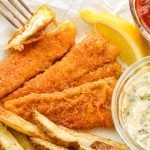
Low FODMAP Air Fryer Fish and Chips (Gluten-Free)
- Total Time: 1 hour
- Yield: 2 servings 1x
- Diet: Gluten Free
Description
Enjoy a healthier, low FODMAP, gluten-free version of a British classic comfort food dish with this Low FODMAP Air Fryer Fish and Chips recipe! Serve with homemade low FODMAP tartar sauce and ketchup for an even more delicious meal.
Ingredients
For the Chips (a.k.a. "Fries):
- 1 pound russet potatoes (about 2 large potatoes), chopped lengthwise into ¼-inch pieces
- 1 tablespoon garlic-infused olive oil
- ¾ teaspoon sea salt
- ¼ teaspoon ground black pepper
For the Fish:
- 3 haddock fillets, thawed if frozen (see notes)
Dredging Station #1:
- 3 tablespoons tapioca flour
- ¼ teaspoon sea salt
- ¼ teaspoon ground black pepper
Dredging Station #2:
- 1 large egg
- 1 tablespoon garlic-infused olive oil
Dredging Station #3:
- 3 tablespoons quinoa flour
- ½ teaspoon paprika
- ½ teaspoon sea salt
- ¼ teaspoon ground black pepper
For Cooking:
- Avocado oil cooking spray (or your cooking spray of choice)
Homemade Low FODMAP Condiments (Optional):
Instructions
- Prepare Condiments (Optional): If using them, prepare homemade low FODMAP ketchup and low FODMAP tartar sauce. Set the saucepan of ketchup somewhere to cool and cover and refrigerate tartar sauce until ready to serve.
- Prepare the Chips: Add chopped potatoes to a large bowl. Add garlic-infused olive oil and toss with your hands to coat. Add salt and pepper and toss again to coat. Spray the air fryer basket with avocado oil cooking spray. Add the potatoes to the basket and evenly distribute. Add the air fryer lid to the Instant Pot Duo Crisp* (or put your air fryer basket in your comparable air fryer). Press the "Air Fry" button, set temperature to 400°F, set the timer for 7 minutes, and press the "Start" button (this procedure will differ for other air fryer models - consult your manual). Cook for 21 minutes at 400°F or until the chips are tender and golden brown, tossing the basket every 7 minutes.* Once cooked, pour the chips from the air fryer basket onto a baking sheet and keep them in a place to keep warm, such as an oven set to 200°F.
- Prepare the Fish: Meanwhile, while the chips are cooking, dry the haddock fillets as best you can with paper towels and place on a cutting board. Using a sharp knife, carefully slice the fillets in half lengthwise to make 6 smaller fillets (which I refer to as “mini-fillets.)
- Set up your Dredging Stations: Place 3 medium-sized bowls and a large piece of parchment paper on the countertop. The bowls are your “dredging stations.” To Dredging Station #1, add tapioca flour, ¼ teaspoon of sea salt and ¼ teaspoon pepper, and whisk to combine. To Dredging Station #2, add 1 large egg and oil, and whisk until egg is beaten and the oil is thoroughly mixed in egg. To Dredging Station #3, add quinoa flour, ½ teaspoon paprika, ½ teaspoon sea salt and ¼ teaspoon ground black pepper, and whisk to combine.
- Bread Fish: Using your hands, dredge your mini-fillets, one at a time, first in dredging station #1 with the tapioca flour, then in dredging station #2 with the egg, and finally in dredging station #3 with quinoa flour, gently shaking off the excess flour and egg after each dredge. Place the breaded mini-fillets on the parchment paper as close to the center as possible, leaving some extra space on the sides of the fish. If you have any leftover quinoa flour mixture from dredging station #3, sprinkle it on top of the breaded fillets to cover up any breading holes your fingers may have created while dredging.
- Add Fish to Air Fryer: Follow these instructions very carefully: Spray air fryer basket again with cooking spray. Right before you add them to the air fryer, spray the top side of the fillets with cooking spray while they’re still on the parchment paper (this can get messy but is necessary). Add the fish to the air fryer basket, sprayed side down, alternating the wide end up so that they all fit in the air fryer basket with some room in between. After they’re all in the basket, spray the tops (the unsprayed side) with more cooking spray. Cook for 6 minutes at 400°F, flipping them with a large spatula halfway through.
- Remove Fish from Air Fryer: Using a large spatula (not tongs as the fillets might fall apart), remove cooked fish from air fryer to a serving platter. Using an instant read thermometer, check the temperature of the thickest mini-fillet. Fish must reach an internal temperature of 145°F to be safely consumed. Using oven mitts, retrieve the chips from the oven and add to the serving platter. Serve with low FODMAP tartar sauce and low FODMAP ketchup.
Equipment

Instant Pot Vortex Plus 10-quart Air Fryer
Buy Now → Buy Now →
Buy Now →  Buy Now →
Buy Now →  Buy Now →
Buy Now →  Buy Now →
Buy Now →  Buy Now →
Buy Now → Notes
- *For the Duo Crisp I typically just set the timer for 7 minutes, ignore the “Turn Food” notification, toss the chips once the 7 minutes is up, and repeat two more times until the chips are cooked.
- Servings: To increase the number of servings to 4, increase quantity of potatoes to 1.5 pounds and double fish ingredients. The chips may need to cook a bit longer, and the fish will need to cook in 2 batches. Add the first batch of fish to the baking sheet in the oven with the chips to keep warm.
- Haddock: full haddock fillets, either fresh or thawed if frozen, are best for this recipe. Sometimes frozen fish comes in large, thick, chunky portions. I don't find that these chunky portions work well as they do not fit well in the air fryer, and it's hard to get them to cook evenly along with thinner fillets. I also found that cod does not hold together as well as haddock in the air fryer.
- Prep Time: 30 minutes
- Cook Time: 30 minutes
- Category: Dinner
- Method: Air Fryer
- Cuisine: British


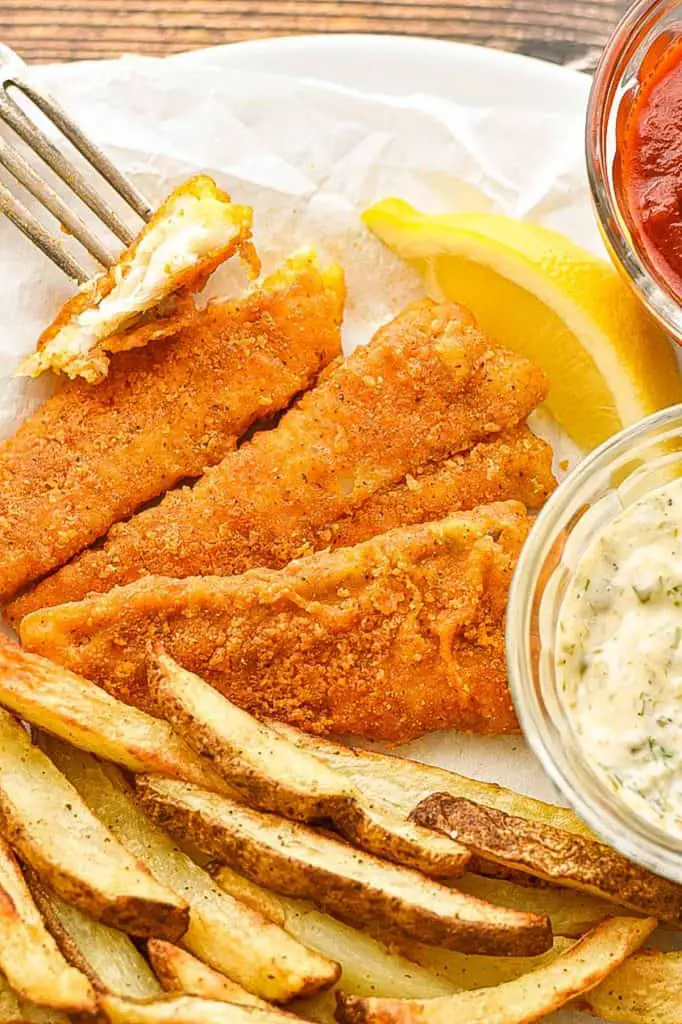
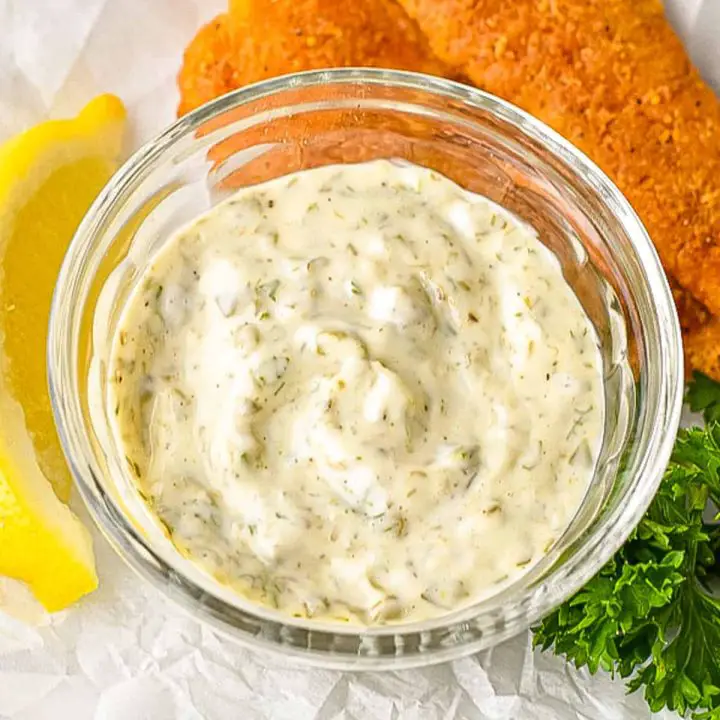

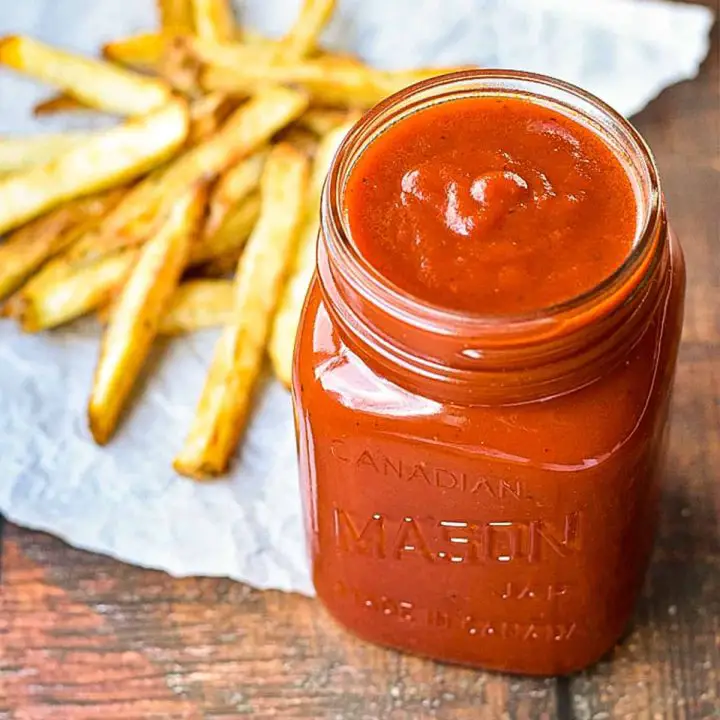


Leave a Reply